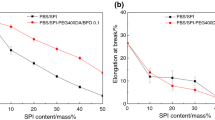Abstract
Self-healing soy-based resins with soy protein isolate (SPI) containing poly(D, L-lactide-co-glycolic acid) (PLGA) microcapsules (MCs) were prepared. Spherical (diameter of 1.30 μm) and elongated MCs (aspect ratios up to 20) were produced using a membrane emulsification technique using syringe filters. Self-healing efficiencies of resins were characterized for their strength recovery and toughness recovery. While both MCs could successfully heal cracks, spherical MCs were seen to compromise the tensile properties of the resin, whereas elongated MCs demonstrated some mechanical enhancement. For resins with elongated MCs, self-healing efficiencies of about 45% and 41% in terms of strength recovery and toughness recovery, respectively, were obtained. For spherical MCs, the self-healing efficiencies were even higher. However, these higher efficiencies were a result of the compromised tensile properties of the resin. The results also showed that higher MC loading results in higher self-healing efficiency. Use of self-healing green resins can extend the useful life of green composites as well as enhance their safety, thus, allowing them to replace currently used petroleum-based composites in many applications.













Similar content being viewed by others
References
Chemat F, Vian MA, Ravi HK (2021) Toward petroleum-free with plant-based chemistry. Curr Opin Green Sustainable Chem 28:100450. https://doi.org/10.1016/J.COGSC.2021.100450
García MC, Torre M, Marina ML, Laborda F (1997) Composition and Characterization of Soyabean and Related Products. Crit Rev Food Sci Nutr 37:361–391. https://doi.org/10.1080/10408399709527779
Kim JR, Netravali AN (2018) Self-Healing Green Polymers and Composites. Advanced Green Composites. John Wiley & Sons, Inc., Hoboken, NJ, USA, pp 135–185. https://doi.org/10.1002/9781119323327.ch7.
Kim JR, Netravali AN (2016) Self-Healing Properties of Protein Resin with Soy Protein Isolate-Loaded Poly(D.L-lactide-co-glycolide) Microcapsules. Adv Funct Mater 26:4786–4796. https://doi.org/10.1002/adfm
Kim JR, Netravali AN (2017) Self-healing starch-based ‘green’ thermoset resin. Polymer 117:150–159. https://doi.org/10.1016/j.polymer.2017.04.026
Mauldin TC, Kessler MR (2010) Self-healing polymers and composites. Int Mater Rev 55:317–346. https://doi.org/10.1179/095066010X12646898728408
Vladisavljević GT (2019) Preparation of microemulsions and nanoemulsions by membrane emulsification. Colloids Surf A 579:123709. https://doi.org/10.1016/J.COLSURFA.2019.123709
Dat Lai Q, Thuy Loan Huynh T, Thuc Trinh Doan N et al (2022) Particle size distribution and homogenisation efficiency in high-pressure homogenisation of wheat germ oil-water system. Int J Food Sci Technol. https://doi.org/10.1111/IJFS.15760
Taha A, Hu T, Zhang Z et al (2018) Effect of different oils and ultrasound emulsification conditions on the physicochemical properties of emulsions stabilized by soy protein isolate. Ultrason Sonochem 49:283–293. https://doi.org/10.1016/j.ultsonch.2018.08.020
Thompson KL, Mable CJ, Lane JA et al (2015) Preparation of pickering double emulsions using block copolymer worms. Langmuir 31:4137–4144. https://doi.org/10.1021/acs.langmuir.5b00741
Fu X, Ohta S, Kamihira M et al (2019) Size-Controlled Preparation of Microsized Perfluorocarbon Emulsions as Oxygen Carriers via the Shirasu Porous Glass Membrane Emulsification Technique. Langmuir 35:4094–4100. https://doi.org/10.1021
Shi S, Netravali AN (2021) Bacterial cellulose integrated irregularly shaped microcapsules enhance self-healing efficiency and mechanical properties of green soy protein resins. J Mater Sci 56:12030–12047. https://doi.org/10.1007/S10853-021-06066-Y
Souzandeh H, Netravali AN (2019) Self-healing of ‘green’ thermoset zein resins with irregular shaped waxy maize starch-based/poly(D,L-lactic-co-glycolic acid) microcapsules. Compos Sci Technol 183:107831. https://doi.org/10.1016/j.compscitech.2019.107831
Murakami H, Kobayashi M, Takeuchi H, Kawashima Y (1999) Preparation of poly(dl-lactide-co-glycolide) nanoparticles by modified spontaneous emulsification solvent diffusion method. Int J Pharm 187:143–152. https://doi.org/10.1016/S0378-5173(99)00187-8
ASTM E647-00 Standard Test Method for Measurement of Fatigue Crack Growth Rates (2020) (n.d.). https://www.astm.org/DATABASE.CART/HISTORICAL/E647-00.htm
Hora MS, Rana RK, Nunberg JH et al (1990) Release of Human Serum Albumin from Poly(lactide-co-glycolide) Microspheres. Pharm Research: Official J Am Association Pharm Scientists 7:1190–1194. https://doi.org/10.1023/A:1015948829632
White SR, Sottos NR, Geubelle PH et al (2001) Autonomic healing of polymer composites. Nature 409:794–797. https://doi.org/10.1038/35057232
Paragkumar NT, Edith D, Six JL (2006) Surface characteristics of PLA and PLGA films. Appl Surf Sci 253:2758–2764. https://doi.org/10.1016/j.apsusc.2006.05.047
Combs JD (2016) Surface FTIR Techniques to Analyze the Conformation of Proteins/ Peptides in H2O Environment. J Phys Chem Biophys 6. https://doi.org/10.4172/2161-0398.1000202
Paniagua-Michel J, Fathepure BZ(2019) Microbial consortia and biodegradation of petroleum hydrocarbons in marine environments. In: Microbial Action on Hydrocarbons. Springer Singapore, pp 1–20https://doi.org/10.1007/978-981-13-1840-5_1
Prosanov IY, Matvienko AA (2010) Study of PVA thermal destruction by means of IR and Raman spectroscopy. Phys Solid State 52:2203–2206. https://doi.org/10.1134/S1063783410100318
Bucknall CB, Heather PS, Lazzeri A (1989) Rubber toughening of plastics. J Mater Sci 1989 24:6. https://doi.org/10.1007/BF02385450
Lapčík L, Maňas D, Lapčíková B et al (2018) Effect of filler particle shape on plastic-elastic mechanical behavior of high density poly(ethylene)/mica and poly(ethylene)/wollastonite composites. Compos Part B: Eng 141:92–99. https://doi.org/10.1016/J.COMPOSITESB.2017.12.035
Nikpur K, Chen YF, Kardos JL (1990) Fracture toughness of unidirectional short-fiber reinforced epoxy composites. Compos Sci Technol 38:175–191. https://doi.org/10.1016/0266-3538(90)90005-P
Guo P, Chen X, Gao X et al (2007) Fabrication and mechanical properties of well-dispersed multiwalled carbon nanotubes/epoxy composites. Compos Sci Technol 67:3331–3337. https://doi.org/10.1016/J.COMPSCITECH.2007.03.026
Sanders P, Young AJ, Qin Y et al(2019) Stereolithographic 3D printing of extrinsically self-healing composites. Scientific Reports 2019 9:1 9:1–6. https://doi.org/10.1038/s41598-018-36828-9
Acknowledgements
The use of the Cornell Center for Materials Research Shared Facilities, which are supported through the NSF MRSEC program (DMR-1719875), is acknowledged. Authors would also like to acknowledge the funding support of Tata Cornell Institute for materials used in this work.
Funding
This study was partially funded by a grant from Tata Cornell Institute as stated above.
Author information
Authors and Affiliations
Corresponding author
Ethics declarations
Conflict of interest
The authors declare that they have no conflict of interest.
Additional information
Publisher’s Note
Springer Nature remains neutral with regard to jurisdictional claims in published maps and institutional affiliations.
Rights and permissions
Springer Nature or its licensor holds exclusive rights to this article under a publishing agreement with the author(s) or other rightsholder(s); author self-archiving of the accepted manuscript version of this article is solely governed by the terms of such publishing agreement and applicable law.
About this article
Cite this article
Shi, S., Netravali, A.N. Elongated soy protein isolate-poly(D, L-lactide-co-glycolic acid) microcapsules prepared using syringe filters and their effect on self-healing efficiency of soy protein-based green resin. J Polym Environ 31, 754–767 (2023). https://doi.org/10.1007/s10924-022-02544-9
Accepted:
Published:
Issue Date:
DOI: https://doi.org/10.1007/s10924-022-02544-9




